
A 2018 article titled "Why Aren't There More Women in Tech?" begins as follows:
Women are under-represented in the tech sector. Not only that, but they're underpaid, often passed for promotions and faced with every day sexism. It's no wonder women are more likely to leave the industry within a year compared to their male counterparts.
The article also contains a chart showing the number of computing jobs held by women in the U.S. shrinking from 37 percent in 1991 to 26 percent in 2014. The application at this link shows that the 37 percent figure for 1991 is very close to the 35.8 percent figure from 1990 Census Data for Mathematical and Computer Scientists, a category represented by codes 64 to 68 in census variable OCC1990.

Mathematical and Computer Scientists (64-68): 1980-2017, grouped by SEX_M_F (percent) Year Count M F 1 1980 325,460 74.0 26.0 2 1990 764,141 64.2 35.8 3 2000 1,850,484 67.1 32.9 4 2005 1,918,711 69.0 31.0 5 2006 2,003,247 68.8 31.2 6 2007 2,095,234 69.0 31.0 7 2008 2,190,804 70.5 29.5 8 2009 2,237,742 70.2 29.8 9 2010 2,203,053 69.9 30.1 10 2011 2,322,285 69.5 30.5 11 2012 2,353,568 70.3 29.7 12 2013 2,506,109 69.9 30.1 13 2014 2,685,135 69.9 30.1 14 2015 2,767,952 70.8 29.2 15 2016 2,932,714 70.4 29.6 16 2017 3,075,192 70.6 29.4 URL parameters (short)= ?minyear=1980&STATE=&geo=NATION&occ=Mathematical%20and%20Computer%20Scientists%20(64-68)&group=SEX_M_F&sortn=4&ymin=26&ymax=36&color=red,red&geomtype=Line%20GraphAs can be seen, the percentages of women tech workers rose from 26 percent in 1980 to 35.8 percent in 1990 and then dropped steadily. It's interesting to note that the H-1B visa was created by the Immigration Act of 1990. It's difficult to tell how much this event coincided with the decline since the census data is only included for each decade until 2000.
In any event, the above table shows a figure of 30.1 percent for 2014, not the 26 percent shown in the chart in the article. It may be that they are using the ACS (American Community Survey) occupation variable OCC which represents the category "Computer and Mathematical Occupations" by codes 1000 to 1299. That results in the following graph and table:

Computer and Mathematical Occupations: 2005-2018, grouped by SEX_M_F (percent) Year Count M F 1 2005 3,149,099 72.2 27.8 2 2006 3,262,368 72.1 27.9 3 2007 3,322,297 72.4 27.6 4 2008 3,459,213 73.1 26.9 5 2009 3,489,558 73.1 26.9 6 2010 3,432,435 72.8 27.2 7 2011 3,555,640 72.9 27.1 8 2012 3,705,799 73.6 26.4 9 2013 3,874,466 73.5 26.5 10 2014 4,121,527 73.7 26.3 11 2015 4,263,596 74.2 25.8 12 2016 4,511,904 74.3 25.7 13 2017 4,738,005 74.5 25.5 14 2018 5,033,745 73.6 26.4 URL parameters (short)= ?minyear=2005&maxyear=2018&STATE=&geo=NATION&occ=Computer%20and%20Mathematical%20Occupations&group=SEX_M_F&sortn=4&color=red,red&geomtype=Line%20GraphThe tables shows a figure of 26.3 percent for 2014, very close to the 26 percent shown in the chart in the article. Since this is different from the 30.1 figure shown in the first table, these categories are obviously not identical. It should also be noted that the latter table includes 2018. This is because the ACS data for 2018 contains the OCC variable but does not currently include the OCC1990 variable.
It was possible to calculate OCC1990 for computer and mathematical occupations by looking at the mapping between OCC and OCC1990 for 2005 through 2017. Following is the mapping that was found:
OCC Codes OCC1990 Codes ---------- ----------------- Min Max Code Description ---- ---- ---- ----------- 700 700 -> 65 Operations and systems researchers and analysts 1000 1009 -> 64 Computer systems analysts and computer scientists 1010 1029 -> 229 Computer software developers 1030 1199 -> 64 Computer systems analysts and computer scientists 1200 1219 -> 66 Actuaries 1220 1239 -> 65 Operations and systems researchers and analysts 1240 1299 -> 68 Mathematicians and mathematical scientistsThe rest of this article uses the OCC1990 variable so that the data can be compared back to 1980. For the broader category of all computer and mathematical occupations, it uses "Math & Computer Scientists & SW Developers (64-68,229)". For the more narrow category of software developers, it uses "Computer software developers (229)".
On the topic of women in tech, following is an excerpt from an article from February 4, 2019 titled "Tech Women in Silicon Valley Likely to Be Foreign-Born":
Silicon Valley, the global center for high-tech innovation, could be renamed "Immigrant Valley." When it comes to technical talent, the engine of Silicon Valley is fueled by foreign-born workers, many of whom are from humble roots. And having worked hard to get here, many have ambitions beyond their day jobs.
The following graphs and table further group workers with computer and mathematical occupations by their citizenship status. These include non-citizens who are usually on visas like the H-1B or F1 (student), naturalized citizens who were born in another country but who have become U.S. citizens, and U.S. born citizens. The latter category also includes citizens who where born abroad to American parents.
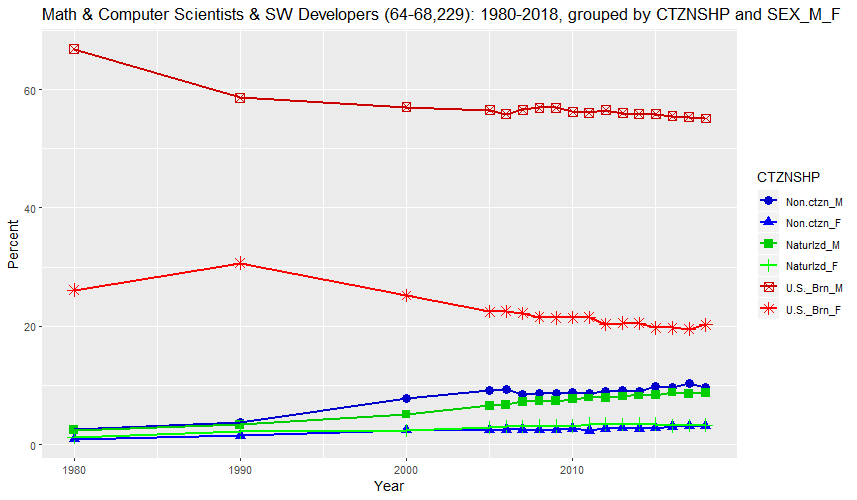
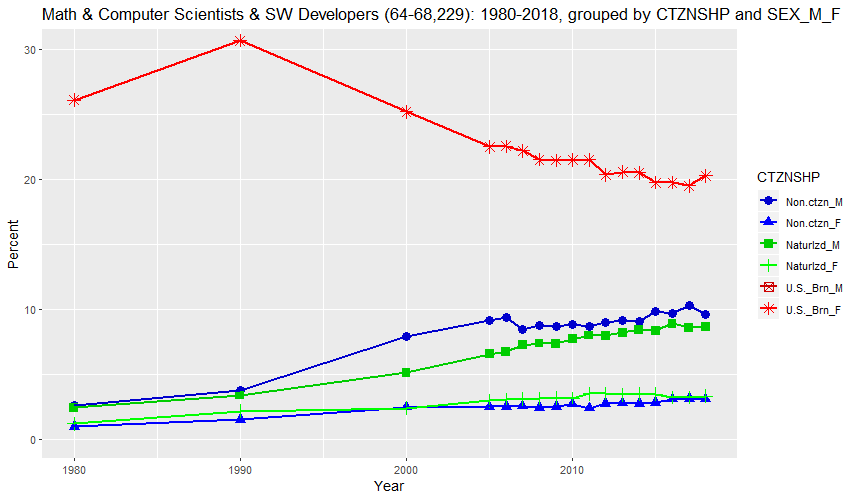
Math & Computer Scientists & SW Developers (64-68,229): 1980-2018, grouped by CTZNSHP and SEX_M_F (percent) Year Count Non.ctzn_M Non.ctzn_F Naturlzd_M Naturlzd_F U.S._Brn_M U.S._Brn_F 1 1980 636,640 2.6 0.9 2.4 1.2 66.8 26.1 2 1990 1,408,313 3.7 1.5 3.4 2.2 58.6 30.7 3 2000 3,199,495 7.9 2.4 5.1 2.4 57.0 25.2 4 2005 3,198,708 9.1 2.5 6.5 2.9 56.5 22.5 5 2006 3,318,303 9.4 2.5 6.7 3.0 55.9 22.5 6 2007 3,385,718 8.4 2.5 7.2 3.1 56.6 22.2 7 2008 3,523,679 8.7 2.4 7.4 3.1 56.9 21.5 8 2009 3,563,731 8.6 2.5 7.3 3.2 56.9 21.4 9 2010 3,518,876 8.9 2.7 7.7 3.1 56.2 21.5 10 2011 3,665,822 8.7 2.4 8.0 3.5 56.0 21.5 11 2012 3,803,465 9.0 2.7 7.9 3.5 56.5 20.3 12 2013 3,986,605 9.1 2.8 8.2 3.4 56.0 20.5 13 2014 4,232,114 9.1 2.7 8.4 3.5 55.9 20.5 14 2015 4,398,425 9.9 2.8 8.3 3.5 55.8 19.7 15 2016 4,643,295 9.6 3.1 8.9 3.2 55.5 19.7 16 2017 4,878,498 10.3 3.1 8.6 3.2 55.3 19.5 17 2018 5,189,315 9.6 3.1 8.7 3.3 55.1 20.3 URL parameters (short)= ?minyear=1980&maxyear=2018&STATE=&geo=NATION&occ=Math%20&%20Computer%20Scientists%20&%20SW%20Developers%20(64-68,229)&group=CTZNSHP|SEX_M_F&sortn=4&color=blue3,blue1,green3,green1,red3,red1&geomtype=Line%20GraphAs can be seen, the percentages of workers of both sexes in the non-citizen and naturalized citizen categories have been generally rising while the percentages of workers in both sexes of U.S. born citizens have been generally dropping, with female workers dropping the fastest and only since 1990. These figures are for the entire U.S. The following table and graph show the figures for Santa Clara County, the county in Silicon Valley with the most tech workers:
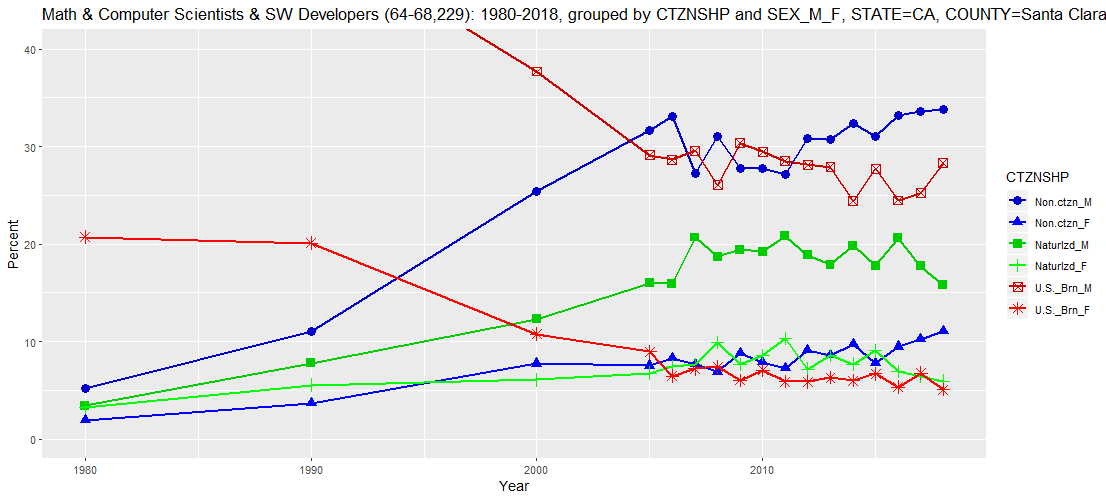
Math & Computer Scientists & SW Developers (64-68,229): 1980-2018, grouped by CTZNSHP and SEX_M_F, STATE=CA, COUNTY=Santa Clara (percent) Year Count Non.ctzn_M Non.ctzn_F Naturlzd_M Naturlzd_F U.S._Brn_M U.S._Brn_F 1 1980 13,520 5.2 1.9 3.4 3.3 65.5 20.7 2 1990 31,908 11.0 3.7 7.8 5.5 51.9 20.1 3 2000 75,758 25.4 7.7 12.3 6.1 37.7 10.8 4 2005 61,136 31.6 7.5 16.0 6.8 29.1 9.0 5 2006 74,124 33.1 8.3 16.0 7.5 28.7 6.5 6 2007 69,727 27.3 7.7 20.7 7.6 29.6 7.2 7 2008 81,284 31.0 6.9 18.7 9.9 26.0 7.4 8 2009 69,865 27.8 8.8 19.4 7.6 30.3 6.0 9 2010 75,966 27.8 7.9 19.2 8.6 29.5 7.0 10 2011 77,883 27.2 7.3 20.8 10.3 28.5 5.9 11 2012 83,941 30.8 9.1 18.9 7.2 28.2 5.9 12 2013 88,624 30.7 8.6 17.9 8.6 27.9 6.3 13 2014 101,409 32.4 9.7 19.8 7.7 24.4 6.0 14 2015 107,500 31.0 7.8 17.8 9.0 27.7 6.7 15 2016 116,481 33.2 9.5 20.6 6.9 24.5 5.3 16 2017 119,613 33.6 10.2 17.7 6.4 25.2 6.8 17 2018 120,741 33.9 11.0 15.8 6.0 28.3 5.1 URL parameters (short)= ?minyear=1980&maxyear=2018&COUNTY=Santa%20Clara&geo=NATION&occ=Math%20&%20Computer%20Scientists%20&%20SW%20Developers%20(64-68,229)&group=CTZNSHP|SEX_M_F&sortn=4&color=blue3,blue1,green3,green1,red3,red1&geomtype=Line%20GraphAs can be seen, the percentage of workers who are U.S. born women has dropped from 20.1 percent in 1990 to 5.1 percent in 2018. Following are the same figures for Alameda County, the county in Silicon Valley with the second most tech workers:
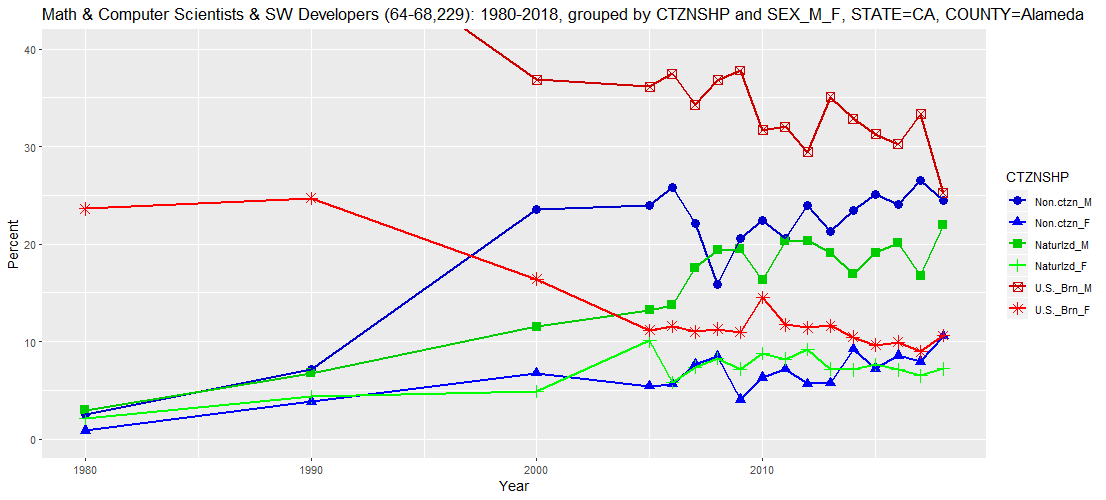
Math & Computer Scientists & SW Developers (64-68,229): 1980-2018, grouped by CTZNSHP and SEX_M_F, STATE=CA, COUNTY=Alameda (percent) Year Count Non.ctzn_M Non.ctzn_F Naturlzd_M Naturlzd_F U.S._Brn_M U.S._Brn_F 1 1980 4,740 2.5 0.8 3.0 2.1 67.9 23.6 2 1990 15,704 7.1 3.8 6.8 4.3 53.3 24.7 3 2000 38,495 23.6 6.7 11.5 4.9 36.9 16.4 4 2005 32,323 24.0 5.4 13.2 10.1 36.2 11.1 5 2006 35,120 25.8 5.6 13.7 5.8 37.5 11.6 6 2007 41,369 22.1 7.7 17.6 7.4 34.3 11.0 7 2008 35,558 15.8 8.5 19.4 8.3 36.8 11.3 8 2009 43,750 20.6 4.0 19.5 7.2 37.8 10.9 9 2010 37,627 22.5 6.3 16.3 8.8 31.7 14.5 10 2011 35,936 20.6 7.1 20.3 8.2 32.0 11.7 11 2012 44,973 24.0 5.7 20.3 9.2 29.4 11.4 12 2013 46,144 21.3 5.7 19.1 7.2 35.1 11.6 13 2014 53,711 23.4 9.2 16.9 7.1 32.9 10.5 14 2015 63,622 25.1 7.2 19.1 7.6 31.3 9.7 15 2016 72,176 24.1 8.5 20.1 7.1 30.2 10.0 16 2017 67,758 26.6 7.9 16.7 6.5 33.3 9.0 17 2018 78,710 24.4 10.5 22.0 7.2 25.2 10.6 URL parameters (short)= ?minyear=1980&maxyear=2018&COUNTY=Alameda&geo=NATION&occ=Math%20&%20Computer%20Scientists%20&%20SW%20Developers%20(64-68,229)&group=CTZNSHP|SEX_M_F&sortn=4&mincount=1000&ymax=40&color=blue3,blue1,green3,green1,red3,red1&geomtype=Line%20GraphAs can be seen, the percentage of workers who are U.S. born women has dropped from 24.7 percent in 1990 to 9 percent in 2017 but has rebounded a bit to 10.6 percent.
The third table above shows that 20.3 percent of U.S. workers in computer and mathematical occupations in 2018 were U.S. born women. However, an article titled "Women make up just 11% of the developer workforce" begins:
Recent data from the Pearson Frank Java and PHP Salary Survey found that just over one in every 10 developers is a woman. In the web developer community, it is no secret that there are very few female developers.
Redoing the prior nationwide graphs and table and changing the occupations from all computer and mathematical occupations to just software developers results in the following:
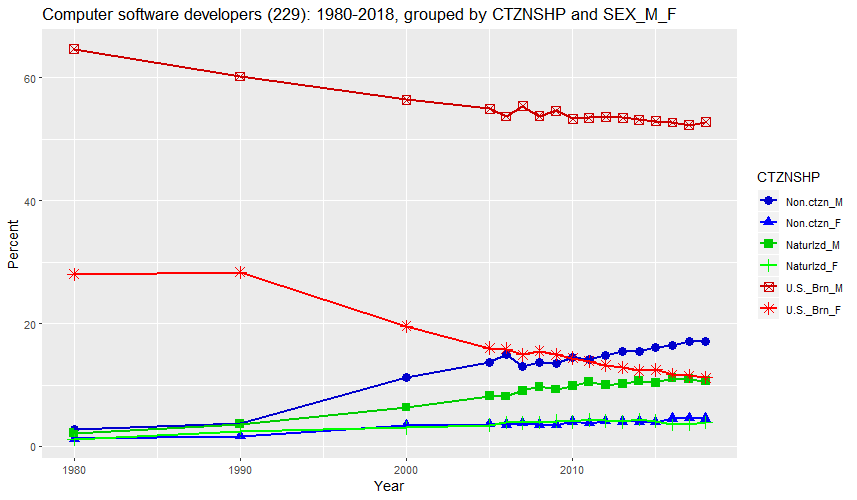
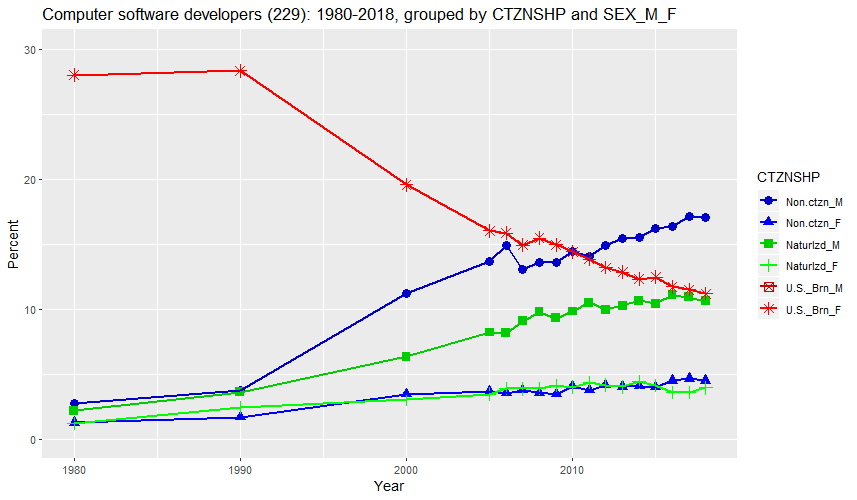
Computer software developers (229): 1980-2018, grouped by CTZNSHP and SEX_M_F (percent) Year Count Non.ctzn_M Non.ctzn_F Naturlzd_M Naturlzd_F U.S._Brn_M U.S._Brn_F 1 1980 311,180 2.7 1.3 2.2 1.2 64.6 28.0 2 1990 644,172 3.7 1.7 3.6 2.4 60.2 28.3 3 2000 1,349,011 11.2 3.5 6.3 3.0 56.4 19.6 4 2005 1,279,997 13.7 3.7 8.2 3.5 55.0 16.0 5 2006 1,315,056 14.9 3.5 8.1 3.9 53.7 15.9 6 2007 1,290,484 13.0 3.7 9.1 3.9 55.4 14.9 7 2008 1,332,875 13.6 3.5 9.7 3.9 53.8 15.5 8 2009 1,325,989 13.5 3.4 9.3 4.1 54.6 14.9 9 2010 1,315,823 14.4 4.1 9.8 4.0 53.3 14.4 10 2011 1,343,537 14.1 3.8 10.5 4.3 53.5 13.9 11 2012 1,449,897 14.9 4.1 10.0 4.2 53.7 13.2 12 2013 1,480,496 15.4 4.0 10.2 4.0 53.5 12.8 13 2014 1,546,979 15.5 4.1 10.6 4.4 53.1 12.3 14 2015 1,630,473 16.2 4.0 10.4 4.1 52.9 12.5 15 2016 1,710,581 16.4 4.5 11.1 3.6 52.7 11.7 16 2017 1,803,306 17.1 4.6 10.9 3.6 52.2 11.5 17 2018 1,853,801 17.0 4.5 10.6 3.9 52.8 11.2 URL parameters (short)= ?minyear=1980&maxyear=2018&STATE=&geo=NATION&occ=Computer%20software%20developers%20(229)&group=CTZNSHP|SEX_M_F&sortn=4&color=blue3,blue1,green3,green1,red3,red1&geomtype=Line%20GraphAs before, the percentages of workers of both sexes in the non-citizen and naturalized citizen categories have been generally rising while the percentages of workers in both sexes of U.S. born citizens have benn generally dropping, with female workers dropping the fastest and only since 1990. As can be seen, the percentage of software developers who are U.S. born women dropped to 11.2 percent in 2018. Furthermore, the percentage nationwide has been dropping steadily since 1990, when it was 28.3 percent.
The above table and graph are for the entire U.S. The following table and graph show the figures for software developers in Santa Clara County, the county in Silicon Valley with the most tech workers:
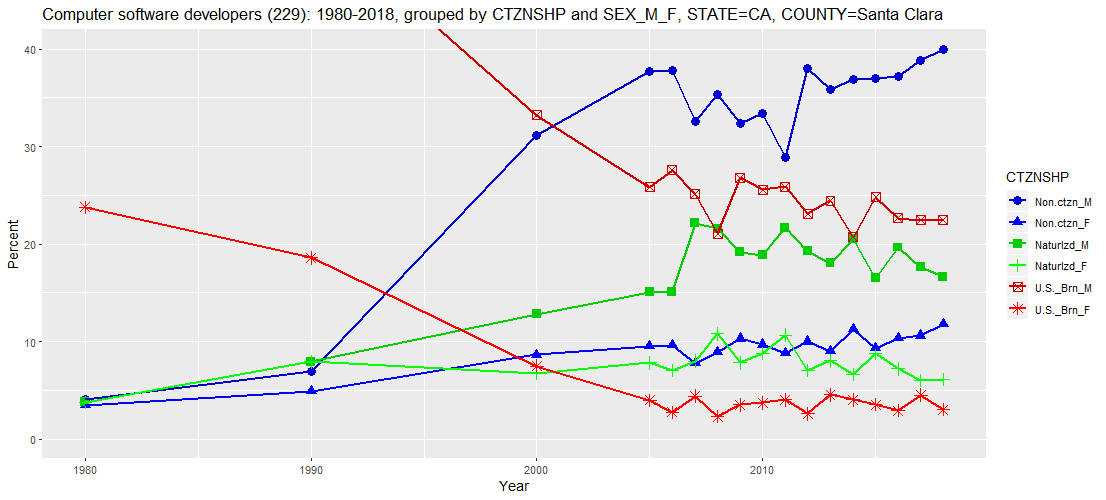
Computer software developers (229): 1980-2018, grouped by CTZNSHP and SEX_M_F, STATE=CA, COUNTY=Santa Clara (percent) Year Count Non.ctzn_M Non.ctzn_F Naturlzd_M Naturlzd_F U.S._Brn_M U.S._Brn_F 1 1980 6,900 4.1 3.5 3.8 3.8 61.2 23.8 2 1990 12,993 6.9 4.9 8.0 7.9 53.7 18.6 3 2000 47,667 31.2 8.6 12.8 6.7 33.2 7.5 4 2005 39,754 37.7 9.5 15.1 7.8 25.8 4.0 5 2006 52,282 37.9 9.6 15.1 7.1 27.6 2.7 6 2007 47,764 32.6 7.8 22.2 8.0 25.1 4.4 7 2008 52,573 35.3 8.9 21.6 10.8 21.1 2.3 8 2009 48,555 32.4 10.3 19.2 7.8 26.8 3.5 9 2010 52,260 33.4 9.7 18.9 8.8 25.6 3.7 10 2011 54,744 28.9 8.8 21.7 10.7 25.9 4.0 11 2012 58,637 38.0 10.0 19.3 7.0 23.1 2.6 12 2013 63,361 35.9 9.0 18.1 8.0 24.5 4.5 13 2014 74,352 36.9 11.3 20.5 6.6 20.7 4.0 14 2015 78,269 37.0 9.3 16.5 8.8 24.8 3.5 15 2016 85,011 37.2 10.3 19.7 7.2 22.7 2.9 16 2017 90,412 38.8 10.6 17.6 6.0 22.4 4.5 17 2018 88,430 40.0 11.8 16.6 6.1 22.4 3.0 URL parameters (short)= ?minyear=1980&maxyear=2018&COUNTY=Santa%20Clara&geo=NATION&occ=Computer%20software%20developers%20(229)&group=CTZNSHP|SEX_M_F&sortn=4&mincount=1000&ymax=40&color=blue3,blue1,green3,green1,red3,red1&geomtype=Line%20GraphAs can be seen, the percentages of workers of both sexes who are non-citizen software developers have been generally rising. One interesting thing to note is that the percentage who were male went down sharply from 2007 to 2011 following the financial crisis but rebounded sharply in 2012. Since 2005, the percentages of software developers who were naturalized citizens has remained fairly steady, with males rising slightly and females dropping slightly. Meanwhile, the percentages of software developers who are U.S. born dropped sharply from 1980 to 2005 and have dropped slightly since then with the drop for males being a bit more noticable. However, U.S. born female developers have remained at a very low level since 2005, between 2.3 and 4.5 percent of developers.
Following are the same figures for Alameda County, the county in Silicon Valley with the second most tech workers:
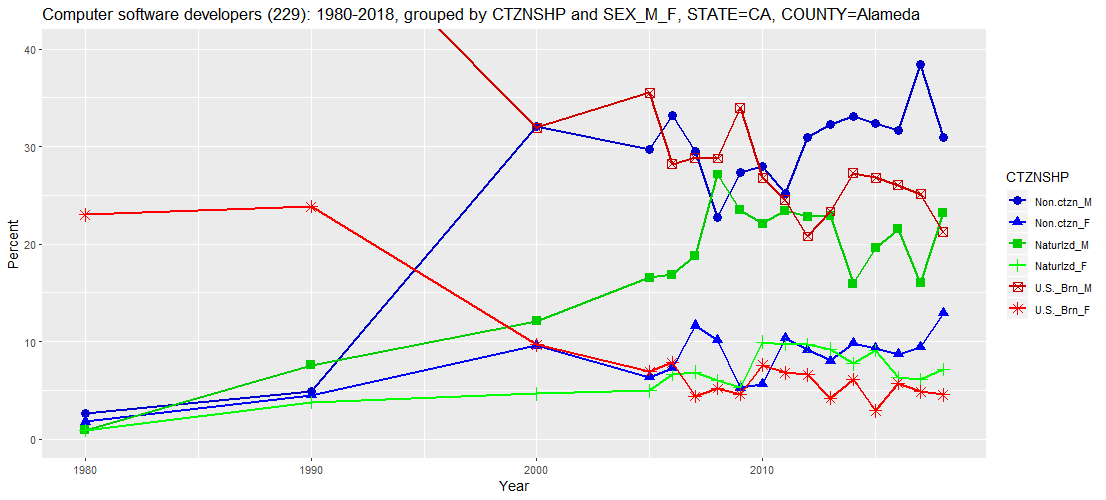
Computer software developers (229): 1980-2018, grouped by CTZNSHP and SEX_M_F, STATE=CA, COUNTY=Alameda (percent) Year Count Non.ctzn_M Non.ctzn_F Naturlzd_M Naturlzd_F U.S._Brn_M U.S._Brn_F 1 1980 2,260 2.7 1.8 0.9 0.9 70.8 23.0 2 1990 6,794 4.9 4.5 7.6 3.8 55.4 23.8 3 2000 20,473 32.1 9.6 12.1 4.6 31.9 9.7 4 2005 18,805 29.7 6.4 16.6 5.0 35.5 6.9 5 2006 19,851 33.2 7.3 16.9 6.6 28.2 7.8 6 2007 24,022 29.5 11.6 18.8 6.9 28.9 4.4 7 2008 17,616 22.7 10.1 27.1 6.0 28.8 5.2 8 2009 21,447 27.4 5.2 23.5 5.3 34.0 4.6 9 2010 20,199 28.0 5.6 22.1 10.0 26.8 7.6 10 2011 20,975 25.2 10.3 23.4 9.7 24.5 6.8 11 2012 24,480 31.0 9.1 22.8 9.7 20.8 6.6 12 2013 25,526 32.3 8.0 22.9 9.2 23.4 4.2 13 2014 29,970 33.1 9.8 15.9 7.7 27.3 6.1 14 2015 38,938 32.3 9.3 19.6 9.1 26.8 2.9 15 2016 44,341 31.6 8.7 21.5 6.3 26.1 5.7 16 2017 39,393 38.5 9.4 16.0 6.1 25.1 4.9 17 2018 48,897 30.9 12.9 23.2 7.1 21.2 4.5 URL parameters (short)= ?minyear=1980&maxyear=2018&COUNTY=Alameda&geo=NATION&occ=Computer%20software%20developers%20(229)&group=CTZNSHP|SEX_M_F&sortn=4&mincount=1000&color=blue3,blue1,green3,green1,red3,red1&geomtype=Line%20GraphThe trend of the percentages for Alameda County are generally similar to the trends for Santa Clara County. As in Santa Clara County, U.S. born female developers have been the category with the smallest percentages. However, these percentages have been between 2.9 and 7.8 percent of developers, a bit higher than the 2.3 to 4.5 percent for Santa Clara County.
The prior two graphs and tables show that the percentage of software developers in 2018 who were U.S. born women in Santa Clara and Alameda Counties in Silicon Valley were 3.0 and 4.5 percent, respectively. The following table shows the 50 counties in the U.S. in 2018 which had the lowest percentages. This list includes only counties with 5,000 or more software developers.
Computer software developers (229): 2018, grouped by CTZNSHP and SEX_M_F (percent) Year COUNTY Count Non.ctzn_M Non.ctzn_F Naturlzd_M Naturlzd_F U.S._Brn_M U.S._Brn_F 1 2018 Palm Beach County FL 5,919 11.5 5.0 14.7 14.0 52.9 1.9 2 2018 Somerset County NJ 6,526 26.6 8.5 20.2 14.2 28.5 2.0 3 2018 Denton County TX 10,928 24.3 7.9 8.8 7.7 49.0 2.2 4 2018 Hudson County NJ 13,746 51.4 11.8 11.0 4.6 18.5 2.7 5 2018 Orange County CA 23,486 14.3 5.2 23.4 10.8 43.5 2.8 6 2018 Santa Clara County CA 88,430 40.0 11.8 16.6 6.1 22.4 3.0 7 2018 Forsyth County GA 5,898 38.0 16.4 18.9 5.2 18.1 3.3 8 2018 Salt Lake County UT 8,842 4.5 2.9 8.8 2.7 77.6 3.4 9 2018 Utah County UT 10,119 1.0 7.0 1.5 0.0 86.8 3.8 10 2018 Middlesex County NJ 18,228 48.0 9.1 21.2 3.0 14.8 3.9 11 2018 Hillsborough County FL 8,414 30.4 2.4 5.4 5.8 51.4 4.5 12 2018 Alameda County CA 48,897 30.9 12.9 23.2 7.1 21.2 4.5 13 2018 DuPage County IL 12,402 20.7 8.0 11.1 5.9 49.7 4.7 14 2018 Oakland County MI 13,294 28.8 5.6 9.2 3.2 48.5 4.7 15 2018 Franklin County OH 9,498 19.1 2.3 9.3 0.0 64.6 4.7 16 2018 Washington County OR 13,413 22.1 6.9 9.1 6.2 50.8 4.8 17 2018 Collin County TX 18,895 24.6 8.9 16.7 7.1 37.6 5.1 18 2018 Dallas County TX 17,573 29.8 10.8 7.0 1.6 45.6 5.3 19 2018 New York County NY 14,937 19.2 3.2 13.4 2.8 56.0 5.5 20 2018 Contra Costa County CA 12,080 23.8 3.9 21.7 11.9 33.2 5.5 21 2018 Philadelphia County PA 5,478 16.5 0.0 10.0 2.2 65.4 5.8 22 2018 Hennepin County MN 16,824 13.1 13.2 8.2 1.6 58.0 5.8 23 2018 Ventura County CA 6,202 14.6 0.0 21.4 2.7 55.4 6.0 24 2018 Lake County IL 7,041 22.0 10.2 12.2 4.9 44.5 6.1 25 2018 Snohomish County WA 10,919 27.0 4.5 7.5 5.9 48.8 6.2 26 2018 Johnson County KS 9,543 19.1 3.1 7.2 17.7 46.7 6.2 27 2018 Nassau County NY 5,390 5.6 0.9 19.6 8.8 58.5 6.6 28 2018 San Mateo County CA 17,104 33.1 11.9 19.1 2.9 26.3 6.7 29 2018 Hamilton County OH 5,301 22.5 1.6 3.9 0.0 64.8 7.1 30 2018 Orange County FL 8,397 4.6 6.5 9.1 3.8 68.7 7.3 31 2018 St. Louis County MO 10,818 30.5 3.3 3.2 3.9 51.5 7.6 32 2018 Loudoun County VA 14,311 16.4 4.7 15.9 11.7 43.6 7.8 33 2018 Travis County TX 20,848 13.9 2.2 14.9 4.9 56.2 7.9 34 2018 King County WA 80,283 33.3 6.3 10.9 2.9 38.8 8.0 35 2018 San Francisco County CA 30,518 17.6 1.4 11.3 3.6 57.9 8.2 36 2018 Cook County IL 35,685 19.8 5.7 10.5 2.2 53.2 8.6 37 2018 Montgomery County MD 13,303 9.3 3.4 28.2 4.8 44.9 9.5 38 2018 Bergen County NJ 7,455 25.4 5.0 20.8 7.7 31.3 9.8 39 2018 Mecklenburg County NC 8,839 34.5 6.4 7.7 3.8 37.8 9.8 40 2018 Queens County NY 8,711 18.1 1.9 24.6 0.7 44.6 10.1 41 2018 San Diego County CA 28,326 17.5 3.1 18.3 2.7 48.3 10.2 42 2018 Pinellas County FL 6,173 11.6 0.9 3.0 4.0 69.7 10.8 43 2018 Gwinnett County GA 6,322 8.1 4.0 19.0 5.1 52.8 11.0 44 2018 Cuyahoga County OH 5,154 13.3 7.3 6.9 2.5 58.8 11.1 45 2018 Broward County FL 6,694 16.5 5.6 32.2 1.4 33.1 11.1 46 2018 Chester County PA 7,391 36.5 6.0 5.1 6.8 34.5 11.1 47 2018 Harris County TX 18,668 28.7 7.0 7.3 5.4 40.3 11.4 48 2018 Arlington County VA 5,738 5.3 0.0 3.8 8.6 70.9 11.4 49 2018 Kings County NY 16,397 12.1 1.2 18.6 5.9 50.8 11.5 50 2018 Williamson County TX 9,860 15.3 1.9 5.9 4.9 60.3 11.7 URL parameters (short)= ?minyear=2018&maxyear=2018&STATE=&geo=COUNTY&occ=Computer%20software%20developers%20(229)&group=CTZNSHP|SEX_M_F&sortn=9&sortdir=Ascending&totrows=50&color=blue3,blue1,green3,green1,red3,red1&geomtype=Line%20GraphAs can be seen, Santa Clara and Alameda Counties ranked as numbers 6 and 12, respectively. Another cluster of nearby counties in the top 20 are Somerset, Hudson, and Middlesex Counties in New Jersey and New York County, New York, all near New York City. Another cluster of nearby counties are Denton, Collin, and Dallas Counties, all near Dallas, Texas.
There are many articles that explore the reasons for why there are so few women in tech. One interesting one is an August 8, 2017 article in the Guardian titled "Why are there so few women in tech? The truth behind the Google memo".
One possible factor mentioned in the article is cultural differences between countries. It states:
Prof Dame Wendy Hall, a director of the Web Science Institute at the University of Southampton, points to the wide variation in gender ratios in computing internationally, which she argues would not be seen if there were a universal biological difference in ability between the sexes. While only 16% of computer science undergraduates in the UK - and a similar proportion in the US - are female, the balance is different in India, Malaysia and Nigeria.
"I walk into a classroom in India and it's more than 50% girls, the same in Malaysia," says Hall. "They are so passionate about coding, Lots of women love coding. There just aren't these gender differences there."
Further on, the articles states the following about the west:
Hall believes that the gender gap and the "male computer geek" stereotype can be dated back to the advent of the home computer in the early 80s, when the machines were marketed heavily as gaming systems for men. She suspects this might be more culpable for women's low participation than men having evolved a mindset better suited to writing lines of code.
"Women were turned off computing in the 80s," she says. "Computers were sold as toys for the boys. Somehow that cultural stigma has stuck in the west in a way that we can't get rid of and it's just getting worse. The skills gap is going to get huge."
Further on, the article brings up an interesting point that I have not heard made before:
As we move into a future in which algorithms have greater influence on our lives - from communication to healthcare, transport to the law - the gender balance in tech companies goes beyond what is fair for their employees. The result of male domination of tech has led to the development of, for example, voice recognition technologies that, trained and tested solely by men, struggle to understand female voices. It has resulted in virtual reality technologies that disproportionally impose motion sickness on women. At this early moment in its history, the tech industry is already littered with products that have gender bias effectively programmed into them.
The article concludes:
"As we go into the world of AI, when people are designing algorithms that help us live our lives, it will be very bad if that's all done by men," says Hall. "Social care, looking after kids, so many aspects of our lives. We really need as many people as possible doing this. It's really important and it's going to get more important."
Hall invokes her late mentor Karen Spärck Jones, a pioneering British computer scientist who campaigned hard to encourage more women into the field. As she used to say: "Computing is too important to be left to men."